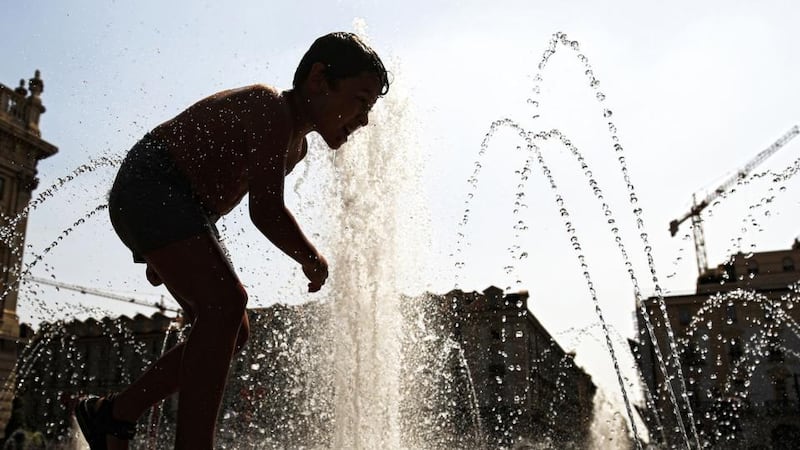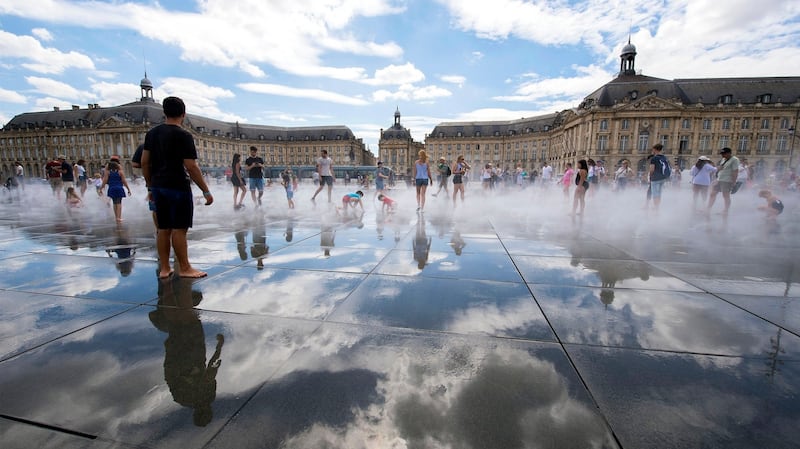Eleven southern and central European countries have issued extreme-heat warnings amid a brutal heatwave nicknamed Lucifer, with residents and tourists urged to take precautions and scientists warning that worse could be to come.
Authorities in Italy, Switzerland, Hungary, Poland, Romania, Bosnia, Croatia and Serbia are on red alert, the European forecasters' network Meteoalarm said, and swathes of southern Spain and France are on amber.
As temperatures in many places hit or exceeded 40 degrees in the region’s most sustained heatwave since 2003, emergency services are being put on standby and people have been asked to “remain vigilant”, stay indoors, avoid long journeys, drink plenty of fluids and listen for emergency advice from health officials.

At least two people have died from the heat, one in Romania and one in Poland, and many more been taken to hospital suffering from sunstroke and other heat-related conditions. Italy said its hospitalisation rate was up 15 per cent on the normal level and asked people in affected regions to travel only if their journey was essential. Polish officials warned of possible infrastructure failures.
Irish holidaymakers have been advised to take extra precautions in the sun and follow local advice.
A spokesman from the Department of Foreign Affairs called on all Irish citizens travelling to countries affected by the heatwave to follow local advice and take all necessary precautions. He also recommend that Irish travellers take out comprehensive travel insurance and prepare for their trip using the department’s TravelWise app.
Kevin O’Hagan, Cancer Prevention Manager at the Irish Cancer Society, advised travellers to keep out of the sun between 11am and 3pm and to wear light, loose fitting clothing, hats and sunglasses. Mr O’Hagan also reminded Irish holidaymakers to use sunscreen with SPF 30 or higher, reapplying it every two hours.
Parents are advised to keep babies under six months in the shade as much as possible and to remember that 90 per cent of UV rays can pass through cloud on overcast days.
A spokeswoman for Abta, the UK travel-trade organisation, reinforced the advice for holidaymakers, saying they should take sensible precautions, keep hydrated by drinking plenty of water, stay out of the sun in the middle of the day, and follow any advice issued by health authorities in specific destinations.
Droughts and wildfires
The heatwave, now in its fourth day and expected to last until next Wednesday, follows an earlier spell of extreme temperatures last month that fuelled a spate of major wildfires, exacerbated droughts in Italy and Spain, and damaged crops.
The highest temperature on Thursday was 42 degrees, in Cordoba, Spain, and Catania, Italy. Split, in Croatia, also hit 42.3 degrees on Wednesday. The spell is forecast to peak at the weekend with temperatures of 46 degrees or higher in Italy and parts of the Balkans.
Authorities in Italy, which is suffering its worst drought in 60 years, have put 26 cities, including Venice and Rome, on the maximum extreme-heat alert. Many of Rome’s fountains have been turned off, and last week the city only narrowly averted drastic water rationing.

In Florence the Uffizi art gallery was temporarily closed on Friday when its air conditioning broke down. In Hungary, keepers at Budapest zoo cooled down two overheating polar bears with huge ice blocks.
Temperatures along parts of Croatia's Adriatic coast, including Dubrovnik, were expected to hit 42 degrees during the day. In the Serbian capital of Belgrade there were reports of people fainting from heat exhaustion.
43-degree highs in Spain
Highs in Spain, including in popular holiday resorts on the Costa del Sol and on the island of Majorca, are set to reach 43 degrees this weekend, with extreme conditions also forecast in Seville, Malaga and Granada. Ibiza and Majorca could hit 42 degrees, Spain’s Aemet meteorological service warned.
While Europe’s record high is 48 degrees, set in Athens in 1977, current temperatures are in many places as much as 10-15 degrees higher than normal for the time of year and likely to result in more fatalities, experts have said.
Europe’s record-breaking 2003 heatwave resulted in more than 20,000 heat-related deaths, mainly of old and vulnerable people, including 15,000 in France, where temporary mortuaries were set up in refrigerated lorries.
Such spells of extreme heat in southern Europe could be a foretaste of things to come. French researchers last month predicted summer conditions in some of the continent's popular tourist destinations could become significantly tougher.
“Mega-heatwave”
Writing in the journal Environmental Research Letters, the scientists said if a similar "mega-heatwave" to that of 2003 were to occur at the end of the century, when average temperatures are widely expected to be noticeably higher after decades of global warming, temperatures could pass 50 degrees.
The researchers noted that climate models suggest “human influence is expected to significantly increase the frequency, duration and intensity of heatwaves in Europe” and said their modelling suggested that by 2100 peak summer temperatures could rise by between 6 and 13 degrees against historical records.

The village of Conqueyrac, in the Gard department of France, hit 44.1 degrees twice in the summer of 2003, the highest temperature ever recorded in the country, meaning “the record maximum value could easily exceed 50 degrees by the end of the 21st century”, the scientists concluded.
The current extreme temperatures, coupled with strong winds, have fanned wildfires that have already caused more than 60 deaths this summer in Portugal and caused widespread damage in southern France, Greece and Italy.
Firefighters
About 300 firefighters and military personnel were fighting 75 wildfires on Friday in Albania, with firefighters also busy in Serbia, Bosnia, Macedonia, Croatia, Greece and the French island of Corsica.
In Italy fires killed a 79-year-old woman in the central Abruzzo region and forced the closure of the main Via Aurelia coastal motorway that runs northwards from Rome to the Italian Riviera.
The country's winemakers have started harvesting their grapes weeks earlier than usual because of the heat. The founder of the Slow Food movement, Carlo Petrini, said no harvest in living memory had begun before August 15th.
The heatwave is likely to cost Italy’s agricultural sector billions of euro, with as many as 11 regions facing critical water shortages. Olive yields in some areas are forecast to be down 50 per cent, and some milk production has fallen by 30 per cent.
Bosnian officials said the heatwave and drought had nearly halved agricultural output, which represents 10 per cent of the country’s economic output, and Serbia said its corn production could be cut by a third.
© Guardian














